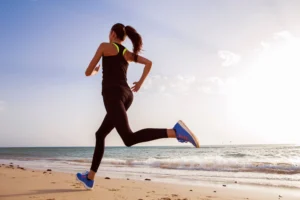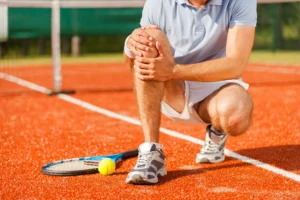Stay in the Game: Common Summer Sports Injuries & How to Prevent Them
 Summer days bring endless opportunities for exercise and athletic activity—with tennis racquets, golf clubs, bicycles, and running shoes emerging from hibernation. Intensified time on the courts, fields, courses, and trails can have an unwelcome sidekick: sports injury. Sidelining professional athletes, weekend warriors, and amateurs alike, sports injuries affect millions of Americans each year. In fact, sports injuries are among the most common reasons for adults to visit their doctors and the emergency room.
Summer days bring endless opportunities for exercise and athletic activity—with tennis racquets, golf clubs, bicycles, and running shoes emerging from hibernation. Intensified time on the courts, fields, courses, and trails can have an unwelcome sidekick: sports injury. Sidelining professional athletes, weekend warriors, and amateurs alike, sports injuries affect millions of Americans each year. In fact, sports injuries are among the most common reasons for adults to visit their doctors and the emergency room.
Sidelined
Sports injuries can impact any part of your body’s structure—including bones, muscles, ligaments, and tendons. In some cases, a sports injury may be acute in that it happens suddenly from an incident like a slip or fall. In other cases, a sports injury may be chronic in that it develops over time as a result of repetitive stress, strain, or overuse. Among the most common summer sports injuries are sprains and strains, Achilles tendon ruptures, and knee, elbow, and shoulder injuries.
- Sprains: Ankle sprains, one of the most common sprains, can happen if you roll, turn, or twist your ankle in an unnatural way—stretching or tearing the ligaments that help hold your ankle bones together. Sprains vary in severity, with some resolved with rest, ice, compression, and elevation and others requiring rehabilitation.
- Strains: Strains come in all shapes and sizes, and are often caused by overextension or overuse. Shin pain, known as shin splints, happen if you overuse your lower legs. Engaging in high-impact activities like running make you more prone to shin splints, which are typically resolved with rest. Among the most common muscle strains are injuries to the hamstrings, the group of three muscles that run along the back of your thigh.
 If you play a sport—like tennis, basketball, or soccer—that involves lots of suddenstops and sprints, you may be more likely to experience a hamstring injury, which usually resolves with rest. Sometimes, severe strains can result in tears such as a hip labral tear, which involves tearing the ring of cartilage outside the hip socket. Sudden twisting motions common in sports like golf can lead to hip joint strain and tear. In some cases of a hip labral tear, physical therapy may be necessary.
If you play a sport—like tennis, basketball, or soccer—that involves lots of suddenstops and sprints, you may be more likely to experience a hamstring injury, which usually resolves with rest. Sometimes, severe strains can result in tears such as a hip labral tear, which involves tearing the ring of cartilage outside the hip socket. Sudden twisting motions common in sports like golf can lead to hip joint strain and tear. In some cases of a hip labral tear, physical therapy may be necessary. - Achilles tendon rupture: Connecting the muscles in the back of your calf to your heel bone is your Achilles tendon. When this tendon is overstretched, it can rupture—causing sudden, sharp pain in your ankle and lower leg. If you engage in a sport that involves running, jumping, and sudden starts and stops, you may be more prone to an Achilles tendon rupture, which, for many people, can be resolved with nonsurgical treatments.
- Knee Injury: Your anterior cruciate ligament (ACL) is the tissue that connects your thighbone to the shinbone at the knee. Sports—like tennis and soccer—that involve sudden twisting motions and sudden stops and starts, can result in ligament tears. Treatments for ACL tears depend upon the injury’s severity and often include rehabilitation exercises to regain strength and stability.
- Elbow Injury: Tennis elbow, one of the most common elbow injuries, causes pain around the tendons in your elbow. While tennis elbow can indeed be caused by the repetitive wrist and forearm movements that occur during a game of tennis, the injury can actually be caused by any activity—such as golf or baseball—involving these repetitive motions.
- Shoulder Injury: The repetitive, overhead arm motions involved in summer sports like swimming, volleyball, and baseball can result in shoulder damage including rotator cuff injury and tendon tears.
Prevention Playbook
Preparation and patience are key in preventing summer sports injuries. Easing into summer exercise—especially if you’ve been sedentary during the off-season—allows you to gradually recondition your body to endure daily exercise. Stretching is equally as imperative. When you stretch, you increase blood flow to your muscles, which improves their flexibility and allows them to absorb quick turns, twists, and bends.
 For each activity, make sure that you have the proper equipment and know the proper techniques. Gear that doesn’t adequately support your body (like a worn-down pair of running shoes) can cause injury. Also ensure that you understand the sport’s proper stance or movement techniques to avoid moving in a way that could cause injury. Finally, drinking plenty of water before, during, and after athletic activity can help prevent injury. When your body loses water during exercise, your muscles become tense, and if you exercise with tense, cramped muscles, you’re more pone to muscle strains and tears.
For each activity, make sure that you have the proper equipment and know the proper techniques. Gear that doesn’t adequately support your body (like a worn-down pair of running shoes) can cause injury. Also ensure that you understand the sport’s proper stance or movement techniques to avoid moving in a way that could cause injury. Finally, drinking plenty of water before, during, and after athletic activity can help prevent injury. When your body loses water during exercise, your muscles become tense, and if you exercise with tense, cramped muscles, you’re more pone to muscle strains and tears.
To learn more about Anodyne’s sports injury recovery program and how our doctors can restore and improve your muscle strength, endurance, flexibility, and balance— while reducing pain and inflammation—visit https://anodynepain.com/ today.
Related Articles
Whether you’re struggling to diagnose a chronic pain condition or you’re pursuing wellness treatments to stay healthy and feel great, we’re here to support you at every step of your health care journey.
